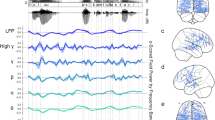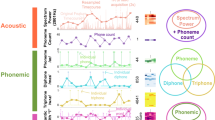Abstract
There are two views about the nature of consonants and vowels. One view holds that they are categorically distinct objects that play a fundamental role in the construction of syllables in speech production1,2,3. The other view is that they are convenient labels for distinguishing between peak (vowel) and non-peak (consonant) parts of a continuous stream of sound that varies in sonority (roughly the degree of openness of the vocal apparatus during speech)4,5,6, or that they are summary labels for bundles of feature segments7,8. Taking the latter view, consonants and vowels do not have an independent status in language processing. Here we provide evidence for the possible categorical distinction between consonants and vowels in the brain. We report the performance of two Italian-speaking aphasics who show contrasting, selective difficulties in producing vowels and consonants. Their performance in producing individual consonants is independent of the sonority value and feature properties of the consonants. This pattern of results suggests that consonants and vowels are processed by distinct neural mechanisms, thereby providing evidence for their independent status in language production.
This is a preview of subscription content, access via your institution
Access options
Subscribe to this journal
Receive 51 print issues and online access
$199.00 per year
only $3.90 per issue
Buy this article
- Purchase on Springer Link
- Instant access to full article PDF
Prices may be subject to local taxes which are calculated during checkout

Similar content being viewed by others
References
McCarthy, J. A prosodic theory of nonconcatenative morphology. Linguistic Inquiry 12, 373–418 (1981).
Clements, G. N. & Keyser, S. J. CV phonology: A Generative Theory of the Syllable LI Monograph Series no. 9 MIT Press, Cambridge, MA, 1983).
Yip, M. Reduplication and C-V skeleta in Chinese secret languages. Linguistic Inquiry 13, 637–661 (1982).
Selkirk, E. in The Structure of Phonological Representations (eds van der Hulst, H. & Smith, N.) Part II (Foris, Dordrecht, 1982).
Goldsmith, J. A. Autosegmental and Metrical Phonology (Blackwell, Oxford, 1990).
MacNeilage, P. F. The frame/content theory of evolution of speech production. Behav. Brain Sci. 21, 499–546 (1998).
Kenstowicz, M. Phonology in Generative Grammar (Blackwell, Oxford, 1994).
Stevens, K. Acoustic Phonetics (MIT Press, Cambridge, MA, 1998).
Miceli, G., Laudanna, A., Burani, C. & Capasso, R. Batteria per l'Analisi dei Deficit Afasici (Centro di Promozione e Sviluppo dell' Assistenza Geriatrica, Roma, 1994).
Romani, C., Granà, A. & Semenza, C. More errors on vowels than consonants: An unusual case of conduction aphasia. Brain Language 55, 144–146 (1996).
Blumstein, S. E. in Syllables and Segments (eds Bell, A. & Hooper, J. B.) 189–200 (North Holland, Amsterdam, 1978).
Canter, G. J., Trost, J. E. & Burns, M. S. Contrasting speech patterns in apraxia of speech and phonemic paraphasia. Brain Lang. 24, 204–222 (1985).
Romani, C. & Calabrese, A. Syllabic constraints in the phonological errors of an aphasic patient. Brain Language 64, 83–121 (1998).
Roelofs, A. Phonological segments and features as planning units in speech production. Lang. Cogn. Processes 14, 173–200 (1999).
Boatman, D., Hall, C., Goldstein, M. H., Lesser, R. & Gordon, B. Neuroperceptual differences in consonant and vowel discrimination: as revealed by direct cortical electrical interference. Cortex 33, 83–98 (1997).
Buckingham, H. The scan-copier mechanism and the positional level of language production: evidence from phonemic paraphasia. Cogn. Sci. 10, 195–217 (1986).
Beland, R., Caplan, D. & Nespoulous, J.-L. The role of abstract phonological representations in word production: evidence from phonemic paraphasias. J. Neurolinguistics 5, 125–164 (1990).
Christman, S. S. Uncovering phonological regularity in neologisms: contributions of sonority theory. Clinic. Linguist. Phonetics 6, 219–247 (1992).
Ramus, F. & Mehler, J. Language identification with suprasegmental cues: a study based on speech resynthesis. J. Acoust. Soc. Am. 105, 512–521 (1999).
Nespor, M. & Vogel, I. Prosodic Phonology (Foris, Dordrecht, 1986).
Levelt, W. J., Roelofs, A. & Meyer, A. S. A theory of lexical access in speech production. Behav. Brain Sci. 22, 1–75 (1999).
Acknowledgements
This research was supported by a grant from the NIH. We thank S. Blumstein, A. Costa, P. Jusczyk, J. Mehler, V. Savova, N. Schiller and K. Stevens for helpful suggestions, and K. Domoto-Reilly for her help in the scoring of the data.
Author information
Authors and Affiliations
Corresponding authors
Rights and permissions
About this article
Cite this article
Caramazza, A., Chialant, D., Capasso, R. et al. Separable processing of consonants and vowels. Nature 403, 428–430 (2000). https://doi.org/10.1038/35000206
Received:
Accepted:
Issue Date:
DOI: https://doi.org/10.1038/35000206
This article is cited by
-
The roots of consonant bias in semitic languages: a critical review of psycholinguistic studies of languages with non-concatenative morphology
Morphology (2023)
-
Neanderthals and Homo sapiens had similar auditory and speech capacities
Nature Ecology & Evolution (2021)
-
Is the consonant bias specifically human? Long–Evans rats encode vowels better than consonants in words
Animal Cognition (2019)
Comments
By submitting a comment you agree to abide by our Terms and Community Guidelines. If you find something abusive or that does not comply with our terms or guidelines please flag it as inappropriate.



